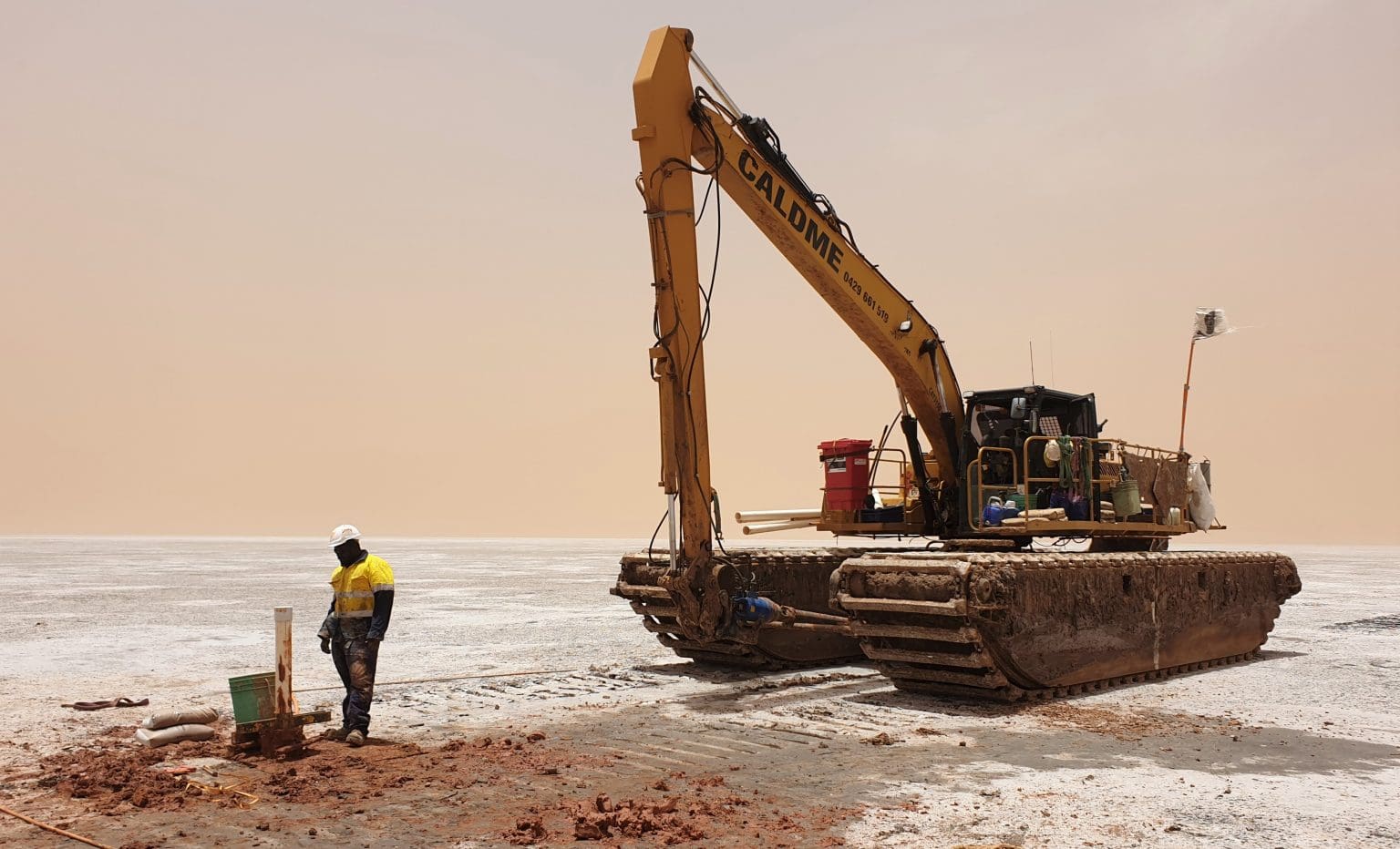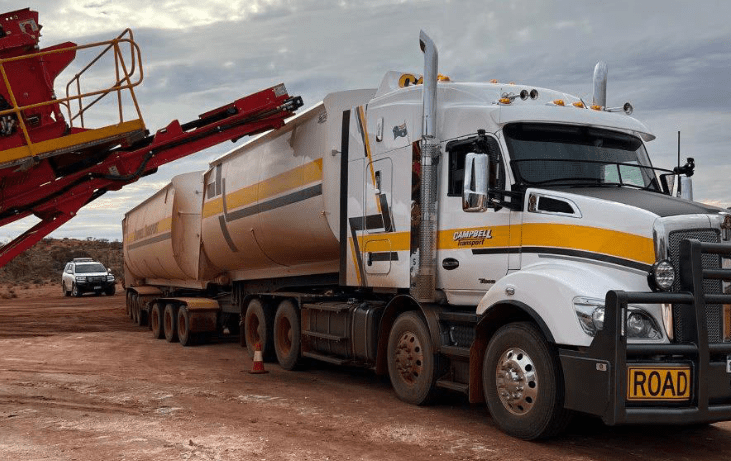
On site at the Kumpupintil Lake Potash Project in WA which is looking at a new processing method to bolster its bottom line. Photo: Reward Minerals
DESPITE almost two decades of industry development and an estimated $1 billion in government loans, the highly anticipated Australian sulphate of potash (SOP) industry has yet to produce any substantial outputs.
Seven Western Australian-based companies have taken on the challenge to take market share in the domestic SOP production industry.
Of these, Australian Potash, Kalium Lakes and SO4 have been placed into administration, and Trigg Minerals and BCI Minerals are putting more capital into mining of other deposits such as salt, gold and copper.
The remaining two, Agrimin and Reward Minerals, are years away from production.
Mining engineer and author of the Australian Potash & Phosphate Report Colin Randall said he estimates about $3B has been invested by governments and shareholders into an industry that has a market value of “less than $300 million”.
“We’ve had absolute destruction of shareholder value,” Mr Randall said.
He estimates that only Kalium Lakes’ Beyondie Potash project achieved any potash outputs, “and I think they had produced 2500 tonnes and that’s it”.
Prime opportunity
Australia imports all of its potash requirements, primarily sourcing SOP from China and muriate of potash (MOP) from Canada, Russia, and Belarus.
In 2021, Australia imported 564,236t of MOP and 63,527t of SOP.
All current or previous SOP mining operations are located in lake systems in WA with the goal of producing the fertiliser via an environmentally-friendly, low-cost salt lake brine process.
The most common method of production, used by market leader China, is the Mannheim Process, which is more expensive and has high carbon emissions.
In its Inputs of the Future report released in December, GrainGrowers estimated that the salt lake brine process would cost $300/t to produce SOP, compared with the Mannheim cost of $700/t.
Mr Randall said it was this anticipated low cost of production and organic classification that came with salt lake brine SOP that spurred on companies and investors.
SOP for grains
SOP is rarely used by the grains industry, which prefers the cheaper MOP, which GrainGrowers said costs about $200/t to produce.
SOP is more commonly used to produce high-value crops, such as fruit, vegetables and tobacco, as it suits plants that are sensitive to the chloride found in MOP.
Keen to appeal to grain-centric WA growers, several companies promoted the potential use of SOP on broadacre crops, arguing that domestic production would reduce costs enough to make it an attractive alternative to MOP.
In 2019, early market entrant Australian Potash funded a two-year glasshouse and field trial comparing SOP and MOP on canola and wheat crops.
Led by the University of Western Australia with WA No-Tillage Farmers Association, the study’s unpublished results reportedly found SOP increased crop yields.
“Early field trials Australian Potash has been involved in show that yields on broadacre crops like canola can increase 30 percent with the application of sulphate of potash when compared with using muriate of potash,” Australian Potash former CEO Matt Shackleton wrote in the Countryman in 2022.
“By establishing a potash industry in the world’s number one-ranked mining jurisdiction, with low sovereign risk and access to supply routes, the WA potash industry will be able to secure supply to Australian farmers, ensuring food security despite uncertain supply worldwide.
“But as well as supply, establishing a homegrown potash industry should also have a downward effect on fertiliser prices in Australia, due to lower freight and shipping costs.”
Newer company Trigg Minerals also spent time talking to growers across the state before its second ASX listing in 2019.
Mr Randall argues that even if grain growers were open to switching to SOP, most of these operations were heavily export focused and had off-take agreements with overseas distributors.
“The location of all of them drove them to have an export component as well.”
One company, Agrimin, has secured agreements with two Chinese and two US organisations for a combined 315,000t of SOP.
What went wrong?
Directors of failed potash companies have blamed a lack of enduring investment and gaps in technology for the collapse of their projects.
Mr Shackleton said the “demise of Western Australia’s nascent potash sector” was a reflection of “a lack of investment sentiment for these project development opportunities”.
In the case of Kalium Lakes, administrators KPMG found due to challenges, the company did not meet production targets which resulted in a funding shortfall.

The first load of Sulphate of Potash loaded at Beyondie in August 2022, and the company went into receivership in 2023. Photo: Kalium Lakes Limited
Also administrators for Salt Lake Potash, KPMG found similar challenges with its operations which “resulted in additional costs being incurred” and an overall funding shortfall.
Mr Randall said all the early companies appeared to have mining backgrounds but did not have a full understanding of the chemistry needed to produce uniform quantities of SOP.
“There was a complete lack of understanding of producing SOP.
“This is not making salt; this is actually taking another dimension.
“The chemistry is complex…simply draining the saline lakes does not provide the consistency of quality.”
Mr Randall said he held hopes for companies such as Reward Minerals, which were investing in new technologies and learning from the mistakes of the failed ventures.
“They realised, with other people failing, how complex it was, and they put effort into technology to try and find a way around the complexities.”
Australian SOP projects
Salt Lake Potash (SO4) – Lake Way
Salt Lake Potash or SO4, brought a lot of confidence to the new industry when it listed on the ASX in 2006 with its Lake Way project located in the Goldfields region.
Aiming to be a “globally significant exporter”, the company claimed Lake Way could produce up to 245,000t per annum of SOP.
Production was set to commence by mid-2021 and was facilitated by a $65M loan from the Federal Government’s Clean Energy Finance Corporation, but by October 2021 S04 was in voluntary administration.
Following several court proceedings and claims directors potentially mislead shareholders, Lake Way was purchased by Czech investment company Se.ven in October 2022.
In a statement on its website, Se.ven claims Lake Way has “reached advanced stages of its development”.
Australian Potash – Lake Wells
Listing in 2011, Australian Potash estimated that it could produce 170,000t per annum of SOP from its Lake Wells site, 500km north-east of Kalgoorlie.
With the help of a $140M loan from the Northern Australia Infrastructure Fund, Australian Potash completed a Front End Engineering Design study in April 2021 and flagged commencement of site construction and establishment of production bores.
Citing “lack of investment support for [the] sector and project”, Australian Potash was placed into administration in August 2023.
On February 1, in an announcement to the ASX, the company exited administration and stated that it would depart the potash industry and instead focus on gold and other minerals.
Kalium Lakes – Beyondie Potash
Located 160km southeast of Newman in the Pilbara region, Kalium Lakes Beyondie Potash was the only project to reach production stage.
Aimed at supplying domestic and international markets, the company eyed 170,000t per annum production.
First production was completed in October 2021, with the first delivery of SOP made to fertiliser manufacturer and distributor CSBP Fertilisers in August 2022.
Receivers were appointed a year later, with the board attributing challenges reaching production targets as the reason for the collapse.
In addition to being the first and only domestic producer of SOP, Kalium Lakes was the only company to default on a NAIF loan, with the fund contributing $74M to the failed project.
Reward Minerals – Kumpupintil Lake Potash Project
First listing on the ASX in 1991, Reward Minerals has focused on innovating technology as a way to improve the financial viability of its SOP operations.
Located 300km east of Newman, the company’s flagship Kumpupintil Lake Potash Project has received WA environmental approvals, and a pre-feasibility study was completed in May 2021.
Since the collapse of Kalium Lakes, Reward Minerals announced it had entered into a binding share sale agreement to potentially acquire the Beyondie Project for $20M.
The company said it plans to use its “newly developed processing technology” at the already developed Beyondie site.
BCI Minerals – Mardie Salt & Potash
Primarily a salt-mining operation, BCI Minerals commenced construction on the Mardie Salt & Potash project in the first quarter of 2022.
Located south of Karratha in the Pilbara region, the operation was predicted to produce 120,000-140,000t of SOP per annum.
BCI was anticipating that it will complete design and cost development studies on the SOP plant between late 2024 and early 2025.
The largest beneficiary of Federal Government funds, BCI received a total of $650M from NAIF and Export Finance Australia.
Trigg Minerals – Lake Throssell, Lake Rason, Lake Yeo
Principally a gold and base-metal exploration company, Trigg Minerals also owns three SOP projects located about 180km east of Laverton.
The Lake Throssell, Lake Rason and Lake Yeo projects are still in early stages.
In December, the company announced it was commencing test work at Lake Throssell in January to “demonstrate an alternative pre-processing approach to that used by the previous SOP operators in Western Australia”.
If successful, the system would be expanded to pilot stage, then into a demonstration-scale plant.
Agrimin – Mackay Potash
Located 940km south of Wyndham Port, Agrimin’s Mackay Potash project is situated at what the company says is the “world’s largest undeveloped SOP brine deposit”.
A definitive feasibility study was completed in 2020, with the company progressing FEED works, tenure and environmental approvals and funding arrangements.
Agrimin said the site could produce up to 450,000t per annum and approximately 70pc of the planned SOP production is under long-term off-take agreements.
Agrimin is also progressing the Lake Auld Potash Project, located 640km south-east of Port Hedland.
Fellow potash industry participant, BCI Minerals is Agrimin’s largest shareholder, owning almost 13pc.
Get our free news straight to your inbox – Click here

A good summary Colin